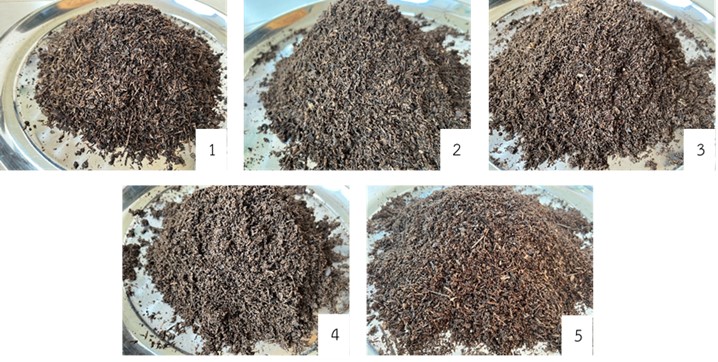Development and Analysis of Growing Media for Lettuce Cultivating from Used Mushroom Culture
Keywords:
used mushroom culture , agricultural waste , plant materials , leafy vegetables , lettuceAbstract
Background and Objectives : In Chom Bueng District, Ratchaburi Province, there is a large amount of mushroom farming, especially the oyster mushroom (Pleurotus spp.) farm, which is grown using mushroom cultures. At the end of the mushroom harvest process, there will be used mushroom culture. This waste material is managed by using it as fertilizer in fields and as an ingredient for making new mushroom culture. However, this method may cause infestation from other fungi that are contaminated in the used mushroom culture. Therefore, the biological fermentation process is used to help digest mushrooms or various fungi and is a process to reduce the amount of carbon and nitrogen so as not to affect the plants. So that waste materials from mushroom cultivation have the potential to be applied in the production of plant-growing materials, which will help reduce the amount of old mushroom lumps thrown into the environment. This research, therefore, utilizes the used mushroom culture by making plant material by fermenting it with various types of organic materials. The objective is to reduce the amount of agricultural waste from mushroom farms by developing planting materials for lettuce and to analyze the physical and chemical properties of the planting material.
Methodology : Used mushroom cultures were fermented with organic materials, including cow dung, Rain Tree leaves, raw rice husks, and bamboo leaves, in various proportions, totaling 5 formulas. The results of the fermentation were studied after 40, 50, and 60 days of fermentation. The planting materials were analyzed for physical and chemical properties, including pH, organic matter content, total nitrogen content, phosphorus content, and potassium content. All planting materials were then tested for growing 15-day-old green oak lettuce and red oak lettuce, approximately 1–2 centimeters tall, in 8x16-inch planting bags. Each bag contained 1 kilogram of planting material. For each planting material, 30 plants were used. The plants were watered thoroughly and placed in an experimental greenhouse covered with a black shade cloth filtering 50% of the light. Watering was done at least 1–2 times a day. Growth measurements were performed using a simple random sampling method, selecting 3 plants per type of vegetable. The plant height and number of leaves were measured once a week until the planting period reached 6 weeks. After 6 weeks of growth, bush size, root length, and fresh weight were measured. Before the planting material was analyzed, it was sieved to remove non-degraded materials. This study was designed as a completely randomized trial. Each set of planting material was repeated 3 times. The obtained data were analyzed using a One-Way Analysis of Variance (ANOVA) with the F-test, and the means of the data were compared using Duncan's Multiple Range Test (DMRT). Microsoft Excel was used for data analysis at the p < 0.05 level. Data are presented as mean ± standard deviation (S.D.).
Main Results : The results showed that after 60 days of fermentation, all planting materials were well decomposed. The yield was 60-75% by volume, indicating that the used mushroom culture can be utilized as a mixture of planting material and to reduce the amount of the used mushroom culture into the environment. In addition, all planting material formulations showed significantly different analytical values (p < 0.05). The suitable planting material is Formula 1 (T2), which contained a mixture of used mushroom culture : cow dung : Rain Tree leaves : raw rice husk : bamboo leaves in the ratio of 1 : 1 : 1 : 1 : 1. After fermenting the planting media for 60 days in plastic baskets, the results of physical and chemical analysis were revealed as followed: the pH was 6.0±0.06, the EC was 1.6±0.10 dS/m, the OC content was 7.23±0.01%, OM was 12.47±0.01%, total nitrogen was 1.08±0.06%, total phosphorus was 0.22±0.03% and total potassium was 0.57±0.03%.
Conclusions : This research has used agricultural waste from mushroom farms to develop into planting materials for green oak lettuce and red oak lettuce, which are vegetables with high consumption. The used mushroom cultures were fermented with organic materials in different ratios, totaling 5 formulas. After 60 days of fermentation, the results of the study found that all planting materials decompose well and yield 60-75 percent by volume. The most suitable planting material is the T2 formula, which is a mixture of leftover mushroom spawns: cow dung: crab claw leaves: raw rice husks: bamboo leaves in a ratio of 1: 1: 1: 1: 1. In addition, the study of the physical and chemical properties of this formula of planting materials found that it has a higher amount of nutrients that can support plant growth than other formulas. When the T2 formula of planting materials was used to grow lettuce, it was found that the plants grew better overall than the other formulas. The plants could also be harvested within 40 days without the need for additional fertilizers.
References
Alexander, M. (1977). Introduction to soil microbiology. 2nd Edition, John Wiley and Sons Inc. New York, USA
Department of Land Development. (2004). Soil and plant management to improve soils low in organic matter. Bangkok: Department of Land Development Ministry of Agriculture and Cooperatives. (in Thai)
Department of Land Development. (2010). Manual for the process of chemical soil analysis analysis. Bangkok: Department of Land Development Ministry of Agriculture and Cooperatives. (in Thai)
Food and Agriculture Organization of the United Nations. (1974). The Euphrates Pilot Irrigation Project. Methods of Soil Analysis, Gadeb Soil Laboratory (A Laboratory manual). Rome, Italy : Food and Agriculture Organization of the United Nations.
Mclean, E.O. (1982). Soil pH and lime requirement. P. 199-224, In: Page, A. L. (ed.), Methods of soil analysis Part 2: Chemical and microbiological properties. American Society of Agronomy, Madison, WI, USA
Meng, X., Dai, J., Zhang, Y., Wang, X., Wanbin, Z., Yuan, X., Yuan, H., & Cui, Z. (2018). Composted biogas residue & spent mushroom substrate as a growth medium for tomato & pepper seedlings. Journal of Environmental Management, 216(1), 62–69.
Naemsai, P. (2003). Effects of seedling media on the growth of vegetable seedlings. Mater Degree Thesis, Department of Horticulture, Faculty of Agricultural Production, Maejo University. (in Thai)
Nakatsuka, H., Oda, M., Hayashi, Y., & Tamura, K. (2016). Effects of fresh spent mushroom substrate of Pleurotus ostreatus on soil micromorphology in Brazil. Geoderma, 269(1), 54–60.
Office of Science for Land Development. (2004). Handbook for analyzing samples of soil, water, fertilizer, plants, soil amendments and analysis to certify product standards, Volume 1. Bangkok: Department of Land Development. (in Thai)
Palaaud, K., Muymas, P., & Plasal, K. (2018). Application of chitin and cow manure for increase the yield of “Butterhead” lettuce grown in pots. Khon Kaen Agriculture Journal, 46(1) SUPPL. 1, 344-349.
Saenmanoch, W. (2021). Efficiency enhancing of spent mushroom cultivation substrate–derived compost by using actinomycetes to green onion (Alliumcepa var. aggregatum) growth andincrease defense against phytopathogenic fungi. Prawarun Agricultural Journal, 18(2), 56–62. (in Thai)
Thongpradistha, S., Muadsri, T., & Sukkaew, A. (2020). The effect of organic fertilizer formula from Sajor-caju mushroom (Pleurotus sajor-caju) waste on macronutrients. Rajamangala University of Technology Srivijaya Research Journal, 12(1), 61-71. (in Thai)
Walkley, A. (1974). A critical examination of a rapid method for determining organic carbon in soil: Effect of variation in digestion conditions and of organic soil constituents. Soil Science, 63, 251-263.
Wongkrachang, S., & Rattaneetoo, B. (2018). Effects of media mixed with local residues in Narathiwat Province for Lactuca sativa var. crispa L. growth. Khon Kaen Agricultural Journal, 46 (SuppL.1), 115-1160. (in Thai)
Zhang, R.H., Duan, Z.Q., & Li, Z.G. (2012). Use of spent mushroom substrate as growing media for tomato & cucumber seedlings. Pedosphere, 22(3), 333–342.

Downloads
Published
How to Cite
Issue
Section
License
Copyright (c) 2025 Faculty of Science, Burapha University

This work is licensed under a Creative Commons Attribution-NonCommercial-NoDerivatives 4.0 International License.
Burapha Science Journal is licensed under a Creative Commons Attribution-NonCommercial-NoDerivatives 4.0 International (CC BY-NC-ND 4.0) licence, unless otherwise stated. Please read our Policies page for more information



